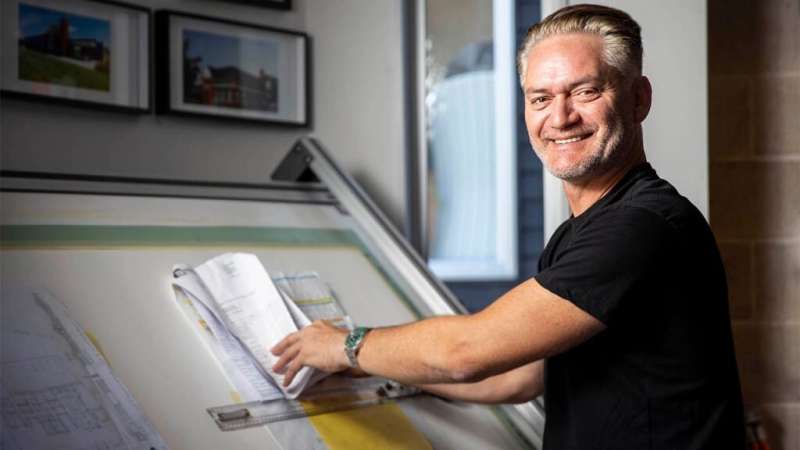Endangered Māori construction methods pass modern seismic testing demands

Recent research conducted by Professor Anthony Hoete has proven that endangered Mātauranga Māori construction techniques, can withstand major earthquakes. He plans to use this knowledge to rebuild a historic Bay of Plenty wharenui.
The original Tānewhirinaki wharenui on Opeke marae near Ōpōtiki was the inspiration behind the study, following Ngāti lra o Waioweka who built the wharenui after the 1860 New Zealand Wars. The iwi later witnessed its demise in a 7.8 magnitude earthquake in 1931.
The most important carvings representing the iwi’s ancestors were saved from the wreckage and remarkably stored in various sheds at the marae for nine decades. However, three attempts to re-stand the whare in subsequent decades failed, due to the loss of Mātauranga (knowledge) on how to reassemble Tānewhirinaki.
Hoete says that the original timber had deteriorated over 90 years and would not be able to carry the loading of a new wharenui.
“So instead, we will design a new structure that will act like an outer whare to which we will sensitively attach the original carvings to the inside of this new structure.”
The project was to enhance the seismic resilience of the new wharenui and its community.
In collaboration with a team from Waipapa Taumata Rau, the University of Auckland, Hoete used endangered construction knowledge called “mīmiro” to create a full-scale timber structure and tested the prototype against earthquake requirements for modern buildings.
“Our seismic tests have demonstrated the structure can withstand much stronger earthquakes than the one that caused critical damage to the original wharenui in the Napier earthquake in 1931,” Hoete says.
Senior lecturer and Māori architectonic researcher Dr. Jeremy Treadwell designed and built the timber portals by using interlocking compression joints, instead of bolting parts together. At the same time, ropes were used to pull the structure to the ground like a tent.
Hoete also collaborated with the Faculty of Engineering to pull the vertical portals sideways and test the horizontal strength of the structure, using a winch off Professor Jason Ingham’s jeep, while the vertical strength was tested using water weights.
Hoete says the origins of mīmiro can be traced back to the ships and strong sail lashing that his ancestors used to travel across the Pacific.
“They had a deep knowledge of building and creating strength and tension in structures, so we have recreated those techniques that have been lost and use them to give our wharenui greater seismic resilience,” said Hoete, who extended the sailing connection by using modern sailing ropes and grinders to create the tension on the timber structure.
The team worked closely with Ngāti lra o Waioweka, who built the original Tānewhirinaki wharenui on Opeke Marae near Opōtiki after the 1860 New Zealand Wars, and later became witness to its demise in the 7.8 magnitude earthquake in 1931.
Hoete says that local hapū, Ngāti Ira, is integral to the project and many local community members assisted in the construction and testing this week.
Riki Kurei, is the restoration project leader for the hapu and says Ngāti Ira is grateful for the support by the University of Auckland and Toka Tū Ake EQC to help his community restore their wharenui.
“The original house was built in 1874, and the inter-locking system at the time was unique compared to any other house in Aotearoa,” Kurei says.
“The ultimate goal for us is to have it standing again in three to five years. That was the dream of our kaumātua since it was pulled down. We will make a reality for our hapū.”
Kurei adds that Ngāti Ira are actively looking for sponsors and support for the restoration of this unique historic wharenui.
“Toka Tū Ake EQC wants to create more resilient communities through the design and construction of stronger buildings. Professor Hoete’s work aligns well with our goal to improve Aotearoa New Zealand’s resilience to natural hazards,” Toka Tū Ake EQC Chief Resilience and Research Officer Dr. Jo Horrocks says.
“Investing in Māori researchers and mātauranga Maōri has been a key focus of this year’s biennial grants, so we are proud to be able to support this amazing project.”
Citation:
Endangered Māori construction methods pass modern seismic testing demands (2023, April 26)
retrieved 26 April 2023
from https://techxplore.com/news/2023-04-endangered-mori-methods-modern-seismic.html
This document is subject to copyright. Apart from any fair dealing for the purpose of private study or research, no
part may be reproduced without the written permission. The content is provided for information purposes only.
For all the latest Technology News Click Here
For the latest news and updates, follow us on Google News.

